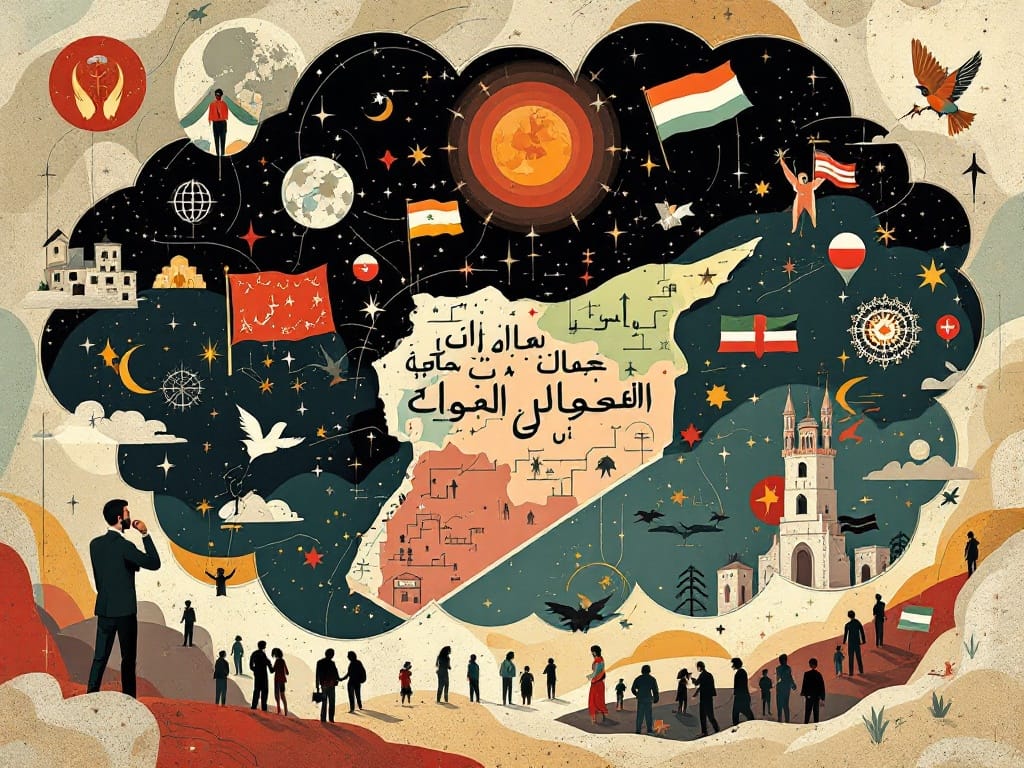

By Dr. Tim Orr
The conflict in Syria is one of the most heartbreaking and complex crises of our time. To understand it, we have to look at the messy layers of religion, politics, and global power struggles that have turned Syria into a devastating battleground. Behind the headlines are real people—families, children, and communities—whose lives have been torn apart. Let’s break this down in a way that makes sense, focusing on what’s happening and why it matters.
The Religious and Sectarian Divide
Syria has always been home to a mix of religious groups, but that diversity has fueled tensions in the conflict. The Assad regime, aligned with the Alawite sect of Shia Islam, has been in power for decades in a country where most people are Sunni Muslims. For years, Sunnis have felt shut out and oppressed, and their frustrations boiled over during the Arab Spring in 2011. What started as peaceful protests quickly escalated into a brutal civil war.
Things got worse when extremist groups like Jabhat al-Nusra and ISIS filled the vacuum. They claimed to fight for Sunni interests but imposed harsh, radical versions of Islam that made life even harder for ordinary Syrians. Meanwhile, the Assad regime received unwavering support from Iran and its proxy group, Hezbollah, because Syria is a strategic link in Iran’s effort to build influence across the Middle East.
On the other side, Sunni-majority nations like Saudi Arabia and Turkey threw their weight behind opposition forces, deepening the sectarian divide. This isn’t just a local conflict—it’s part of a larger regional power struggle between Sunni-led Saudi Arabia and Shia-dominated Iran. Syria became the unfortunate battlefield for this competition.
The Brutality of the Assad Regime
To understand why Syria spiraled into chaos, we need to talk about the Assad regime’s ruthless rule. For over 50 years, the Assad family has gripped Syria with an iron fist. First, under Hafez al-Assad and now his son Bashar, the regime has ruled through fear, oppression, and unimaginable violence.
Hafez al-Assad took power in 1970 and quickly clarified that he would tolerate no dissent. The most infamous example of this came in 1982 with the Hama Massacre when Hafez crushed a Muslim Brotherhood uprising. The army surrounded the city, bombed it relentlessly, and slaughtered an estimated 10,000 to 40,000 people. Entire neighborhoods were flattened, and the message was clear: challenge the regime, and you will pay the price.
When Bashar al-Assad took over in 2000, some thought he might bring reform. He was young, Western-educated, and talked of modernizing Syria. But behind the polished speeches, little changed. The regime’s secret police—known as the Mukhabarat—kept watch over everyone, silencing critics with imprisonment, torture, and disappearances.
In 2011, when the Arab Spring-inspired peaceful protests in Syria, Bashar’s response was swift and brutal. Security forces fired live ammunition at demonstrators. People were detained, tortured, and sometimes never returned to their families. One story that shocked the world was that of Hamza al-Khateeb, a 13-year-old boy whose lifeless, mutilated body was sent back to his family after weeks in custody. Hamza’s death became a symbol of the regime’s unrelenting cruelty.
As the conflict turned into a full-scale war, Assad doubled down. Entire cities and neighborhoods were bombed into rubble. Hospitals and schools—places where people sought safety—became deliberate targets. Then came the chemical weapons. The 2013 sarin gas attack on Ghouta killed over 1,400 people, many of them children. Videos of families gasping for air and bodies lifeless on the ground shocked the world, but Assad faced little more than empty condemnation.
The regime also used starvation as a weapon. Cities like Eastern Ghouta were besieged for years, their residents cut off from food, medicine, and basic supplies. People ate leaves, grass, and even animals to survive. Children waste away in front of their parents. For Assad, these were just tactics to hold onto power—no matter the human cost.
What kept Assad’s regime alive? Russia and Iran. Russia’s military intervention in 2015 turned the tide of the war. Airstrikes destroyed opposition areas, while Iran sent fighters from Hezbollah to back Assad’s ground forces. Together, they ensured Assad stayed in power—but at the expense of millions of innocent lives.
For Syrians, living under Assad means constant fear and suffering. His regime’s brutality turned a peaceful uprising into a nightmare that continues today.
The World Gets Involved
What’s happening in Syria isn’t just about Syrians—it’s about global powers jockeying for influence.
- Russia: Russia has been one of Assad’s biggest backers, stepping in militarily in 2015. Why? It wants to maintain its foothold in the Middle East and keep its naval base in Tartus. For Russia, this conflict is about showing the world that it’s still a global power to be reckoned with.
- The United States: The U.S. originally supported moderate opposition groups but later shifted its focus to defeating ISIS. That’s where Kurdish militias, like the Syrian Democratic Forces (SDF), came in. The problem? Supporting the Kurds upset Turkey, a U.S. ally because Turkey sees Kurdish forces as a threat to its borders.
- Turkey: Turkey has its own goals—mainly keeping Kurdish groups in check and creating a buffer zone to resettle refugees. But its military involvement has added another layer of violence and displacement.
- Iran: Iran’s deep involvement in Syria is part of its larger plan to control a “Shia crescent” stretching from Iran to Lebanon. By propping up Assad, Iran can supply Hezbollah and challenge its main rivals, like Saudi Arabia and Israel.
- Saudi Arabia and the Gulf States: These countries backed Sunni opposition groups in rivalry with Iran. But in many cases, their support ended up strengthening extremist groups, which made the war even messier.
With so many players, Syria has been carved into pieces—some controlled by the regime, others by opposition groups, Kurds, or extremist factions. Every outside power has its agenda, but it’s Syrian families who are paying the price.
The Human Cost
Behind all the politics and power struggles are real human lives. The numbers are staggering:
- Over 500,000 deaths have been reported, and many more are unaccounted for.
- Nearly 12 million Syrians—half the country’s population—have been forced to leave their homes. Millions now live as refugees in neighboring countries, like Turkey, Lebanon, and Jordan, while others made dangerous journeys to Europe.
- Cities like Aleppo, Raqqa, and Homs have been bombed to the ground. Whole neighborhoods are unrecognizable.
- 90% of Syrians now live below the poverty line. Hunger is rampant, and basic services like healthcare and education are collapsing.
- Millions of children have grown up knowing nothing but war. Many have been orphaned, traumatized, or recruited into armed groups. What kind of future will they have?
It’s easy to feel numb to numbers like these, but every statistic represents a person—a father, a mother, a child—who had dreams and hopes like anyone else.
Islam is a Major Problem in Syria: Recognizing the Root
At the heart of Syria’s crisis lies a difficult truth: interpretations of Islam have contributed to the devastation. While not the only factor, Islamic ideologies have fueled sectarian divides, deepened mistrust among communities, and empowered groups that use religion for power. If we fail to recognize and address this root issue, peace will remain out of reach.
The Way Forward: A Long, Painful Road to Peace
Ending the Syrian war won’t happen overnight, but here’s what must happen:
- Inclusive Political Reform: Syrians need a government representing everyone, not just the elites.
- Less Foreign Interference: Outside powers must prioritize stability over their agendas.
- Rebuilding Trust and Opportunity: Extremism thrives on desperation. Syrians need education, jobs, and hope.
- Humanitarian Relief: Millions need food, shelter, and medical care. The world must step up.
- Justice and Accountability: War crimes cannot go unpunished. Syrians deserve peace built on fairness.
- Rebuilding Infrastructure: Schools, hospitals, and homes must be restored to give people a reason to return.
Why Syria’s War Matters to Us All
The Syrian conflict is a sobering reminder of how quickly peace can unravel when injustice, power struggles, and extremism collide. But it’s also a call to compassion.
Syria’s pain has rippled across the globe—through refugee crises, terror attacks, and geopolitical shifts. Ignoring it risks a world where chaos spreads and innocent people pay the price. But if we act—through prayer, awareness, advocacy, and support—we can help Syrians reclaim their future.
Because their story is our story, their pain should stir our hearts. Their hope for peace is a hope we all share.
The question is: will we care enough to make a difference?
References
Cook, D. (2015). Understanding Jihad. University of California Press.
Lesch, D. W. (2017). Syria: The Fall of the House of Assad. Yale University Press.
Phillips, C. (2016). The Battle for Syria: International Rivalry in the New Middle East. Yale University Press.
Triggernometry. (2024, December 15). The best Syria breakdown you'll ever hear - Thomas Small [Video]. YouTube. https://www.youtube.com/watch?v=9SpwHkvmGjs
Weiss, M., & Hassan, H. (2015). ISIS: Inside the Army of Terror. Regan Arts.
Tim Orr is a scholar of Islam, Evangelical minister, conference speaker, and interfaith consultant with over 30 years of experience in cross-cultural ministry. He holds six degrees, including a master’s in Islamic studies from the Islamic College in London. Tim taught Religious Studies for 15 years at Indiana University Columbus and is now a Congregations and Polarization Project research associate at the Center for the Study of Religion and American Culture at Indiana University Indianapolis. He has spoken at universities, including Oxford University, Imperial College London, the University of Tehran, Islamic College London, and mosques throughout the U.K. His research focuses on American Evangelicalism, Islamic antisemitism, and Islamic feminism, and he has published widely, including articles in Islamic peer-reviewed journals and three books.
Sign up for Dr. Tim Orr's Blog
Dr. Tim Orr isn't just your average academic—he's a passionate advocate for interreligious dialogue, a seasoned academic, and an ordained Evangelical minister with a unique vision.
No spam. Unsubscribe anytime.
